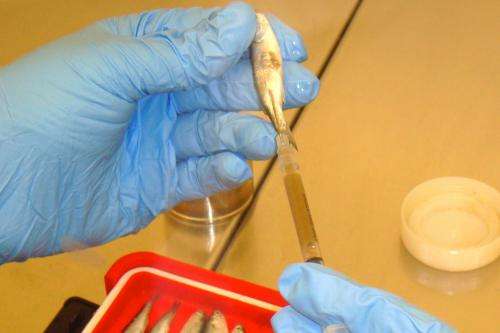New research sheds light on the genetic secrets of deadly algae

(Phys.org) —University of Technology, Sydney research into the genetic makeup of often harmful algae is increasing our understanding of how marine biotoxins can damage global seafood industries and human health.
Despite marine organisms fuelling our fisheries, driving chemical and nutrient cycles and producing 50% of our oxygen, their genetic code remains largely unmapped.
Led by Associate Professor Shauna Murray, UTS marine research has contributed to the first large-scale international study of marine eukaryotic plankton - a diverse group of organisms, some of which can be deadly.
"Eukaryotic plankton are unicellular, microscopic organisms with genomes that can be up to 100 times the size of the human genome," Associate Professor Murray said.
"The enormity of these genomes has made it almost impossible to genetically catalogue these organisms and gather sufficient data to answer fundamental questions about ocean productivity and impacts on human and ecosystem health."
Professor Murray leads the Seafood Safety team within the UTS Plant Functional Biology and Climate Change Cluster (C3). She is an expert on the genetics of marine biotoxins responsible for Ciguatera Fish Poisoning (CFP) and Paralytic Shellfish Poisoning in humans. Her research team's results were recently published in PLoS Biology.
61 institutions have been involved in the study that was prompted by the Gordon and Betty Moore Foundation that asked researchers to select organisms of significance as part of their ongoing Marine Microbiology Initiative. UTS research is significant for its focus on plankton species that have been a problem for Australian fisheries and aquaculture.
"Data generated will aid in the design of novel genetic tools for detecting marine biotoxins," Professor Murray said.
"My work has looked into toxin production genes from Gambierdiscus and Alexandrium plankton species. Many people are familiar with the life threatening impact of CFP on humans who have eaten infected seafood. A bloom of Alexandrium sp caused losses to the Tasmanian aquaculture industry of $20 million in 2012.
"We will next investigate similar organisms using sophisticated bioinformatics tools to target genes and regions that may be useful for future toxin detection work."
Another member of Professor Murray's team, Dr Gurjeet Kohli is investigating maitotoxin (MXT), a little researched but potentially more potent substance than saxitoxin.
To date it has been unclear if MXT has led to human illness, however Dr Kohli's work with carnivorous fish is giving strong signs that the toxin passes up the food chain. Genetic testing has shown MXT to accumulate in carnivorous fish tissues. The results have been published Harmful Algae
"Our results show the potential for MTX to be involved in CFP but more investigations are needed to clarify how the toxin is transmitted in the oceans and the mechanism of its actions on humans," Dr Kohli said.
Journal information: PLoS Biology
Provided by University of Technology, Sydney

















